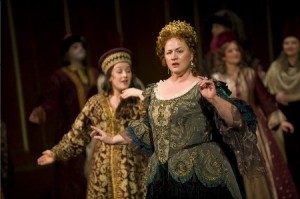Classical Music Review: The BEMF’s Impressive “Dido and Aeneas”
BEMF’s Paul O’Dette and Stephen Stubbs have, once again, produced a work of impeccable and imaginative scholarship for a production that’s not only historically informed, but musically, dramatically, and visually entertaining.

Laura Pudwell performs the role of Dido in the BEMF’s production of DIDO AND AENEAS. Photo: André Costantini
Dido and Aeneas by Henry Purcell and Nahum Tate. Presented by the Boston Early Music Festival. At New England Conservatory’s Jordan Hall, Boston, MA, through November 28.
By Susan Miron
Henry Purcell’s (1659–1695) opera Dido and Aeneas has been so popular over the past 75 years that there have been nearly 50 commercial recordings. I grew up on the record featuring Dame Janet Baker—for me she is the perfect Dido. The record was about 50 minutes long.
Saturday night’s performance by the Boston Early Music Festival (BEMF) clocked in at about an hour longer with not a dull moment. The two co-directors of BEMF had added several pieces of Purcell’s music that fit in perfectly. This is the third chamber opera that the BEMF has produced since 2008; each has featured full costumes and elements of Baroque dance. Their 2009 production of Handel’s Acis and Galatea was a great success. And if the tumultuous applause at the end of last evening is any indication, the BEMF’s Dido and Aeneas falls in the same category.
The libretto by Nahum Tate is based on the story of Dido and Aeneas in the fourth book of Virgil’s Aeneid. No one is really sure about early history of the work—much has disappeared. Only a libretto from an early performance survives. BEMF points out that “the earliest copies of the score come from at least 60 years after the work was composed, and lack the music for the original prologue as well as incidental music and dances indicated in the score.”
The first performance might—or might not have been—at a girls’ school in Chelsea, outside of London in the late 1680s.
BEMF’s Dido and Aeneas is the result of scrupulous scholarship and informed imaginative leaps. In a Boston Globe interview, BEMF’s co-director Stephen Stubbs admits that he sees this project “not only as a reconstruction but also as an attempt to jolt listeners out of their familiarity with a cherished favorite . . . If you think of it like a restorer of a painting, where there’s a corner missing, you can pretty much imagine what I did—try to make the corner feel as if it fits.”
One of the missing corners involves choosing music for the opening, which Stubbs found in one of Purcell’s many songs. Dance and movement are as integral to this performance as it was in the girls’ school in the 1680s that may have first produced this opera. Caroline Copeland and Carlos Fittante, the featured Baroque dancers, were particularly excellent. The many costumes—all recycled from other productions—were apt and often hilarious. The chamber ensemble, a string quartet and harpsichord, were led by the BEMF’s two co-directors, O’Dette and Stubbs, who were fabulous. O’Dette and Stubbs alternately strummed small, Baroque guitars and a very lengthy archlute and theorbo. Both renowned lutenists, they were the heart of the ensemble.

(l-r) Brenna Wells, Jason McStoots, José Lemos, and Carrie Henneman Shaw in BEMF’s production of DIDO AND AENEAS. Photo: André Costantini
To create a more intimate atmosphere, a tapestry covers the back wall of Jordan Hall. As the program notes point out, Dido is less an opera than a “court masque, an exemplar of that unique blend of aural, visual, and intellectual spectacle that embodied the extravagantly self-reflexive ethos of the English court throughout the seventeenth century.”
Several singers were downright wonderful, but if there there were a prize for most entertaining, it would go to Jason McStoots, who, in his most memorable guise, wore a costume that featured a waist big enough to look like a table for two, out of which crept another person. McStoots, a tenor, sang exquisitely, as did Dido’s sister Belinda, played by an up and coming Baroque singer, Yulia Van Doren. The vocal ensemble, twenty people in all, sang with gusto.
For many people, Dido is all about Dido’s Lament, a.k.a. “When I am laid in earth,” one of the most wrenching arias in all of music. Here Dido, Queen of Carthage, realizes she has been abandoned her beloved, the Trojan hero Aeneas. As Dido sings this, one by one the other singers lower themselves to sitting positions, as if the whole world were collapsing around them—a brilliant idea.
This production’s Dido, Laura Pudwell, was, to my ears, disappointing, but to be fair she had some tough competition on CD. I have both Jesse Norman and particularly the late Lorraine Hunt Lieberson in my ears, and Pudwell’s singing, for me, lacks their evocation of raw despair, particularly when Dido sings out in her top register, “Remember me, but ah! forget my Fate!” then melts down to the floor. All the male singers, as well as Douglas Williams as Aeneas, are excellent.
BEMF’s O’Dette and Stubbs have, once again, produced a work of impeccable and imaginative scholarship for a production that’s not only historically informed, but musically, dramatically, and visually entertaining.
Tagged: Boston Early Music Festival, Dido-and-Aeneas, Henry-Purcell, Opera
